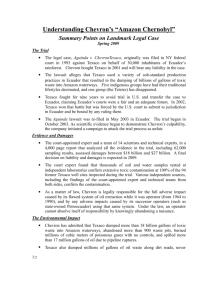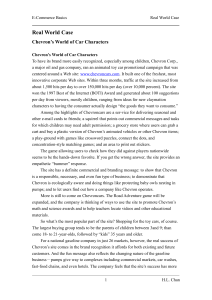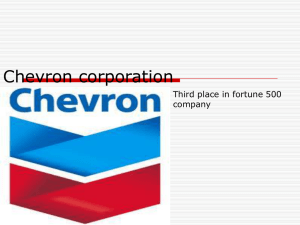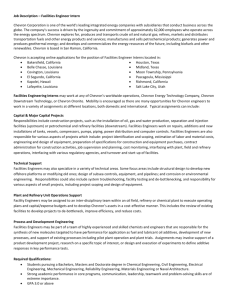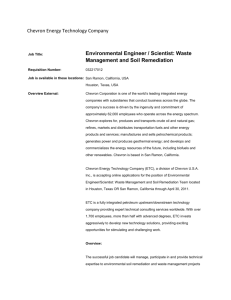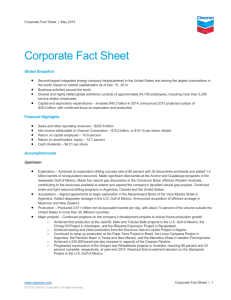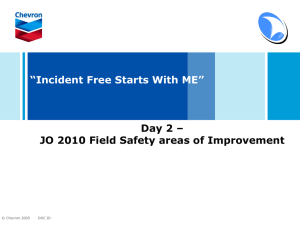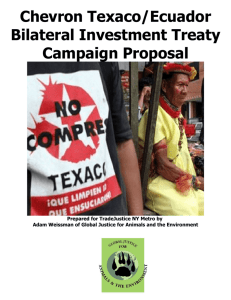Chevron's Ten Biggest Lies About Ecuador
advertisement
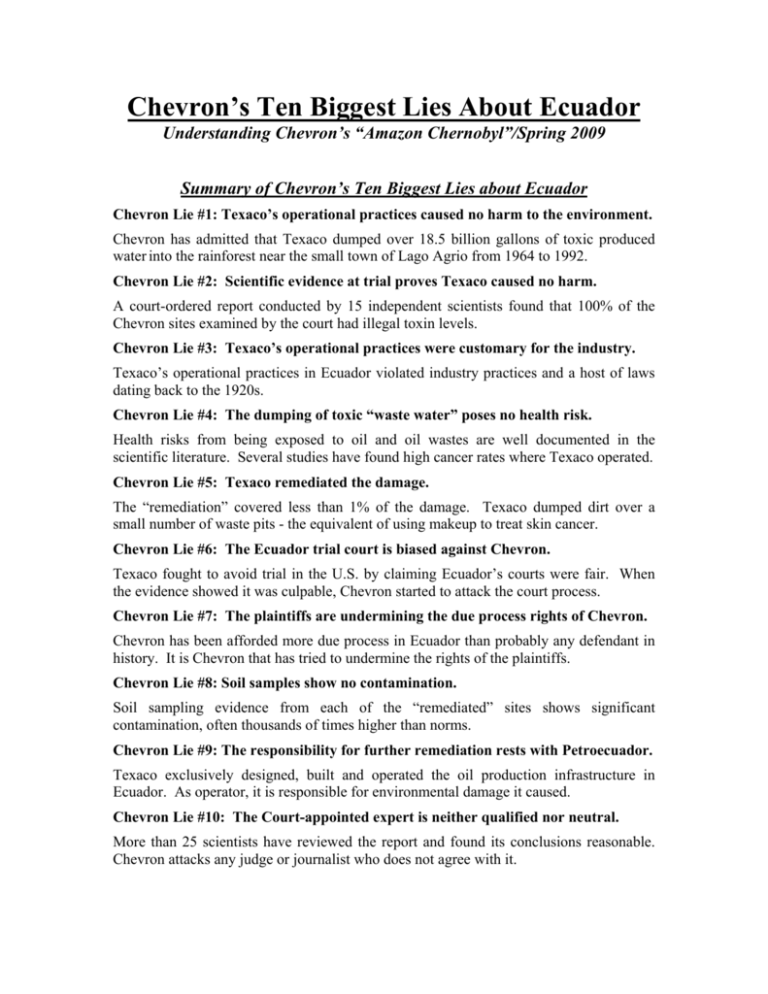
Chevron’s Ten Biggest Lies About Ecuador Understanding Chevron’s “Amazon Chernobyl”/Spring 2009 Summary of Chevron’s Ten Biggest Lies about Ecuador Chevron Lie #1: Texaco’s operational practices caused no harm to the environment. Chevron has admitted that Texaco dumped over 18.5 billion gallons of toxic produced water into the rainforest near the small town of Lago Agrio from 1964 to 1992. Chevron Lie #2: Scientific evidence at trial proves Texaco caused no harm. A court-ordered report conducted by 15 independent scientists found that 100% of the Chevron sites examined by the court had illegal toxin levels. Chevron Lie #3: Texaco’s operational practices were customary for the industry. Texaco’s operational practices in Ecuador violated industry practices and a host of laws dating back to the 1920s. Chevron Lie #4: The dumping of toxic “waste water” poses no health risk. Health risks from being exposed to oil and oil wastes are well documented in the scientific literature. Several studies have found high cancer rates where Texaco operated. Chevron Lie #5: Texaco remediated the damage. The “remediation” covered less than 1% of the damage. Texaco dumped dirt over a small number of waste pits - the equivalent of using makeup to treat skin cancer. Chevron Lie #6: The Ecuador trial court is biased against Chevron. Texaco fought to avoid trial in the U.S. by claiming Ecuador’s courts were fair. When the evidence showed it was culpable, Chevron started to attack the court process. Chevron Lie #7: The plaintiffs are undermining the due process rights of Chevron. Chevron has been afforded more due process in Ecuador than probably any defendant in history. It is Chevron that has tried to undermine the rights of the plaintiffs. Chevron Lie #8: Soil samples show no contamination. Soil sampling evidence from each of the “remediated” sites shows significant contamination, often thousands of times higher than norms. Chevron Lie #9: The responsibility for further remediation rests with Petroecuador. Texaco exclusively designed, built and operated the oil production infrastructure in Ecuador. As operator, it is responsible for environmental damage it caused. Chevron Lie #10: The Court-appointed expert is neither qualified nor neutral. More than 25 scientists have reviewed the report and found its conclusions reasonable. Chevron attacks any judge or journalist who does not agree with it. Long Version of Chevron’s Ten Biggest Lies About Ecuador Does Chevron respect the law and human rights in Ecuador? On its website Chevron has pledged to “conduct business in a socially responsible and ethical manner” and “to respect the communities” where it operates. But Chevron’s conduct in the historic environmental trial in Ecuador’s rainforest – where damages have been assessed at $27 billion – can hardly be considered “ethical” or respectful of human rights. Texaco (now Chevron) was the exclusive operator of an oil concession in Ecuador’s rainforest from 1964 to 1990. To keep costs at a bare minimum, the company admits that it systematically dumped into Amazon waterways 18 billion gallons of toxic waste in an area that was home to six indigenous groups – one of which is now extinct, and five of which have lost most of their ancestral lands. Chevron inherited this problem when it bought Texaco in 2001. Since then, Chevron has treated Ecuador as an image problem to be managed rather than a humanitarian and environmental crisis to be solved. It has hired the global public relations firm Hill & Knowlton, known for representing the tobacco industry for decades, to create the same sort of junk science that the cigarette makers used to deny the link between smoking and lung cancer. When one connects Chevron’s dots in Ecuador, what emerges is a coordinated series of misinformation and frauds designed to deceive courts, the public, shareholders, and the financial markets. The purpose of this scheme is to avoid paying the cost of a real clean-up, and it matters not that vulnerable rainforest peoples – among them thousands of children – have died or suffer as a result. Chevron’s Board of Directors appears to have completely deferred to management on the issue, raising questions about its own corporate governance and fiduciary responsibilities. Chevron Lie #1: Texaco’s operational practices caused no harm to the environment. Chevron has conceded at trial that Texaco systematically and deliberately dumped billions of gallons of toxic “water of formation” directly into the waterways and forests of Ecuador’s Amazon region between 1964 and 1990. This amounted to about four million gallons of toxic waste dumped daily into the middle of the world’s most delicate ecosystem. According to the U.S. government and various scientific studies, water of formation contains a variety of toxic and carcinogenic hydrocarbons, including benzene, toluene, and polynuclear aromatic hydrocarbons. Texaco also abandoned more than 900 open waste pits filled with toxic sludge -- “drilling muds” dug out of the ground when a well is perforated -- that include highly dangerous chemicals such as chromium VI, barium, and lead. For decades these pits have been leaching carcinogenic toxins into groundwater, soils, and streams that the local population relies on for drinking water. Texaco also flared in the open millions of cubic meters of highly poisonous gas, regularly burned the waste pits and dumped the toxic sludge from the pits on roads, and spilled 17 million gallon crude from ruptured pipelines. Experts call the area the “Amazon Chernobyl” and say that cleaning it would dwarf any decontamination ever undertaken. An independent, court-appointed expert recently assessed damages at up to $27 billion – damages that scientific experts for the affected communities believe underestimate the 2 actual harm, given that much of the injury caused by oil exploration to the rainforest and its original inhabitants is irreversible.1 Chevron Lie #2: Scientific evidence at trial proves Texaco caused no harm. An independent, court-appointed expert – assisted by 14 independent scientists -reviewed more than 60,000 chemical sampling results provided as evidence by Chevron, the plaintiffs, and various third-parties. The expert concluded that 100% of the 94 former Texaco well sites and production stations inspected during the trial (of 378 total sites Texaco built) were highly contaminated with toxins harmful to human health, including carcinogens such as Chromium VI. Many contained levels of toxins thousands of times higher than those permitted by Ecuadorian and U.S. norms. Several former Texaco well sites had Total Petroleum Hydrocarbons (hydrocarbons from oil that include the carcinogen benzene) in the soil at more than 3,000 times higher than maximum amounts permitted in California, Chevron’s home state. Worse for Chevron, the court expert found that the company’s own evidence and the plaintiff’s evidence both proved the same thing – that illegal levels of toxic contamination exist at all of Texaco’s former sites. In effect, Chevron’s own scientific evidence is proving the case against itself.2 Chevron Lie #3: Texaco’s operational practices were customary for the industry. Chevron’s practices in Ecuador violated industry customs and legal norms by almost every conceivable measure. The dumping of toxic “water of formation” had been outlawed in the oil-friendly state of Louisiana in 1942. In 1939, Texas outlawed open-air toxic waste pits of the type Chevron built in Ecuador throughout the 1970s and 1980s. The entire oil industry was moving away from the waste disposal methods Texaco used in Ecuador as early as the 1920s. In Ecuador, the dumping of contaminated waste water violated a variety of laws dating back to the early part of the last century. Chevron also violated its operating agreement with Ecuador’s government, which required it to “employ modern and efficient machinery” and to “avoid contamination of waters, airs, and lands.” Finally, by the early 1960s the industry-sponsored American Petroleum Institute, by the early 1960s, was recommending re-injection of “water of formation” before Texaco built its first well in Ecuador. Instead of abiding by this industryrecommended practice, Chevron systematically discharged 18 billion gallons of the “water of formation,” which contains the carcinogen benzene, directly into Amazon waterways.3 Chevron Lie #4: The dumping of toxic “waste water” poses no health risk. The U.S. government links hydrocarbon exposure to cancer, reproductive problems, nervous system damage, immune system impairment, and a host of other health problems. A health evaluation published in the academic journal International Journal of Occupation and Environmental Health found rates of cancer in the area Chevron operated 130% above Ecuador’s norm. Another peer-reviewed academic study found rates of child cancer four times higher in the area where Chevron operated than in other parts of Ecuador. Other peer-reviewed scientific studies have found elevated rates of oil- 3 related health problems such as spontaneous miscarriages and genetic defects. The courtappointed expert in Ecuador, using population and epidemiological data, estimated the contamination in the region where Texaco operated produced more than 1,400 excess cancer deaths. As part of its game of smoke and mirrors, Chevron blames the health problems on coliforms (trace amounts of human feces) in the water. Chevron CEO David O’Reilly has insultingly suggested that the region’s numerous health problems stem from the poor personal hygiene of the local residents. Coliforms, which are common in the water supply throughout many parts of the world, do not derive from oil contamination and absolutely do not cause cancer. This is one reason that dozens of prominent scientists from 17 countries recently signed an open letter criticizing Chevron’s lack of scientific integrity in Ecuador.4 Chevron Lie #5: Texaco remediated the damage. Chevron’s insistence that Texaco undertook and completed a “remediation” in Ecuador is a clear acknowledgement that Texaco is responsible for causing significant environmental damage. That said, the scientific evidence in the trial has made it increasingly clear that Texaco’s self-described “remediation” was nothing more than a choreographed fraud designed to evade any level of accountability for the company’s reckless use of sub-standard operational practices in the planet’s most delicate ecosystem. In 1995, Texaco paid $40 million to conduct a “clean-up” of a small number of its 378 oil production sites in the Amazon. In exchange for promising to clean up, a handful of Ecuadorian government officials gave Texaco a limited release from government claims before a single shovel was put in the ground. (Most of those same government officials are now under criminal indictment in Ecuador for lying about the results of the purported remediation.) In 1995, before any clean-up work was done, Texaco’s lawyers tried to use the “release” to persuade a U.S. federal court to dismiss the pending lawsuit brought by thousands of private Ecuadorian citizens who never signed the release and who were not part of the negotiations. Aside from the utter audacity involved in trying to manipulate a U.S. court in this fashion, the remediation was grossly inadequate. It excluded any clean-up of streams, rivers, or groundwater into which billions of gallons of toxic waste water had been dumped. It excluded 84% of the hundreds of waste pits. Spending on the purported clean-up amounted to far less than 1% of the actual cost of a comprehensive remediation, according to an independent court expert. Of the small number of pits it was required to clean under its contract with Ecuador’s government, Texaco unilaterally excluded dozens of sites by claiming that they were somehow being “used” by the local community (based on a “visual” inspection and without sampling soils or water to determine whether hydrocarbons were present). For those pits Texaco claims to have remediated, the company simply used a bulldozer to run dirt over the top without removing the toxins. It then covered the fresh dirt mounds with plants. The entire approach was the equivalent of treating skin cancer with makeup. Texaco engineers then violated EPA protocols by creating bogus lab results to “confirm” that levels of hydrocarbons were so low they could not be detected. Two former Texaco lawyers (both now working for Chevron and currently supervising the Ecuador litigation), along with the former Ecuadorian government officials, are under criminal indictment in Ecuador for certifying the “remediated” sites as clean.5 4 Chevron Lie #6: The Ecuador trial court is biased against Chevron. Chevron’s animating principle is clear: praise foreign courts when you think you can win, and criticize them as unfair when you think you will lose. To get the case transferred to Ecuador, Texaco submitted 14 expert affidavits to the U.S. federal court praising Ecuador’s courts as a fair and adequate forum to hear the case. Once Texaco got its wish, a trial began and the evidence pointed directly, consistently, and overwhelmingly to Chevron’s culpability. Knowing it would likely lose the trial, Chevron launched a campaign to attack the Ecuadorian court it had once praised to undermine the legitimacy of the expected adverse judgment. For years, Chevron repeatedly has tried to distort Ecuadorian law, present misleading evidence, create fake laboratory test results, politicize the trial by lobbying Ecuadorian and U.S. government officials to extinguish the claims of the plaintiffs, and employ extrajudicial pressure to intimidate the judge and court personnel – all with the goal of preventing a final judgment from being reached. These tactics help explain why the trial process has lasted 16 years and why Chevron’s lawyers have promised the plaintiffs a “lifetime of litigation” if they persist in their claims. Despite this chicanery, Ecuador’s court system likely has afforded Chevron more due process rights than any defendant in the history of civil jurisprudence. The company alone has presented more than 50,000 chemical sampling results and produced almost 200,000 pages of evidence in a trial that has lasted five years in its Ecuador phase. It has been free to inspect any site it wants, turn over any scientific evidence it can generate, present any witness from whom it wants testimony, and present any documentary evidence it can find. The irony is that the court damages expert, Richard Cabrera, confirmed what the plaintiffs have been asserting for some time: that much of Chevron’s evidence overwhelmingly proves the company’s own culpability. It is the scientific data itself that has proven the case against Chevron, not any bias on the part of the courts.6 Chevron Lie #7: The plaintiffs are undermining the due process rights of Chevron. This false claim is a key part of Chevron’s misinformation campaign designed to taint the court that likely will hold it accountable. Aside from its delays, Chevron has resorted to outright corruption to undermine the due process rights of the thousands of rainforest residents who have worked for years to prevail in the unprecedented lawsuit. In 2005, it Chevron was found to have fabricated a military report about a security “threat” from the Cofan indigenous people. The trial judge promptly suspended a critical field inspection on ancestral Cofan territory that was to be attended by almost the entire Cofan people and numerous journalists. The fake military report, confirmed as such by Ecuador’s Ministry of Defense, was produced at an Ecuadorian army base that was used by Chevron’s legal team for lodging and “protection”. Case materials have mysteriously been stolen from the law offices of the plaintiffs and the court-appointed technical expert. Death threats against lawyers for the plaintiffs have been commonplace. What’s more, a high-profile member of the plaintiff’s legal team was violently assaulted outside of her home after a slew of media appearances critical of Chevron. In Washington, the company has lobbied the U.S. Congress to cancel trade preferences for Ecuador to “punish” the country’s government for letting its citizens exercise their right to sue a U.S. company. Chevron 5 has taken out dozens of advertisements in leading Ecuadorian newspapers in what appears to be an effort to intimidate the trial judge into ruling against the plaintiffs and to sway public opinion – a practice that would be prohibited in the U.S. and would likely result in sanctions for Chevron’s lawyers. Clearly, Chevron repeatedly has violated the due process rights of the Ecuadorian citizens to forestall a resolution of the case.7 Chevron Lie #8: Soil samples show no contamination. Like the tobacco industry did for decades, Chevron attacks legitimate science and manufactures its own junk science to make unsupported claims that Texaco’s former sites in Ecuador are free of contamination. Responding to scientific data at the Ecuador trial, a Chevron lawyer, Edward Scott, claimed in a letter to the environmental group Amazon Watch that the results indicate “no sample from these remediated areas contained unsafe levels of potentially toxic metals or hydrocarbons.” Chevron asserts on its website that 99% of all samples taken at the Lago trial pose no threat to human health or the environment. These statements are simply untrue. Science – including Chevron’s own lab reports submitted as evidence – does not lie. Dozens of these so-called “remediated” sites contain levels of dangerous toxins up to thousands of times higher than permitted by U.S. and Ecuadorian law. For example, a sample from the well site Lago 6 has TPH levels at 299,000 parts per million (ppm), even though Chevron reported less than 1,000 ppm from that site to justify its suspect “clean-up” to Ecuador’s government. Other sites demonstrate the same disturbing pattern, as illustrated in the chart below. Chevron’s lead “scientific advisor” for the Lago trial, Sara McMillen, is often quoted in Chevron press releases saying these horrific results actually exonerate the company. Yet McMillen does not have any degree in toxicology or chemistry (the two fields most relevant to the scientific results). No matter which legal or invented standard Chevron cites, the company is in violation of the law when one applies that standard honestly to the levels of toxic contamination being found.8 Examples of Fraud During Chevron’s “Remediation” (Measured in TPHs) Chevron Well Site Lago 02 Lago 06 Sacha 65 Sacha 7A SSF-18 SSF-27 Fake Results Chevron Used to Certify Actual Contamination at Clean-up Using Inappropriate Lab Test Same Site During Trial (1998) (2006) <5,000 ppm 325,000 ppm 4,000 ppm 299,000 ppm 3,600 ppm 32,400 ppm <5,000 ppm 12,700 ppm <5,000 ppm 301,000 ppm <5,000 ppm 26,400 ppm Note: The mean U.S. standard for TPHs in the soil is 100 ppm. Chevron Lie #9: The responsibility for further remediation rests with Petroecuador. Chevron’s attempt to shift responsibility for further clean-up to Petroecuador, Ecuador’s state-owned oil company, is disingenuous. Texaco – not Petroecuador – exclusively 6 designed, built, and operated all of the oil production stations used in its concession area when it was the operator. It is clear that Texaco designed these facilities to pollute, inflating profits by keeping production costs to a bare minimum. It is customary in the oil industry for the operator to bear 100% of the responsibility for environmental damage. Further, Texaco bequeathed its flawed production and operational infrastructure to Petroecuador without making improvements. It knew the contamination would continue for years, as it has. From a legal standpoint, Chevron is not only responsible for Texaco’s pollution – which continues leaching into soils and groundwater to this day – but also for contamination caused by the subsequent use of Texaco’s flawed equipment by Petroecuador. Oil contamination in soils and waters does not just stop the day the operator leaves; it can continue for centuries if not remediated properly. The law makes it clear that an operator cannot absolve itself of responsibility simply by abandoning a nuisance. Petroecuador is not blameless, but in contrast to Chevron, Petroecuador has invested significant sums to upgrade production technologies to minimize the environmental impacts from the deficient equipment left it by Texaco. Chevron also is free to sue Petroecuador for a portion of the damages. In fact, Chevron has done so in the very U.S. federal court in New York that throughout the 1990s Texaco claimed was inadequate to hear the underlying case.9 Chevron Lie #10: The Court-appointed expert is neither qualified nor neutral. One consistent theme of Chevron’s litigation strategy is that any expert or court that exercises actual independence will be attacked as “biased” in favor of the plaintiffs. First, the U.S. court where the case was filed was not good enough to hear the case; then, the very courts in Ecuador that Chevron had praised to get the case transferred out of the U.S. suddenly were not good enough once the evidence demonstrated high levels of toxic contamination at Texaco’s former sites. Now, Richard Cabrera, the court-appointed expert whose skill level so impressed Chevron that it paid him for his expertise in an earlier phase of the trial, became persona non grata to the oil giant once he made it clear he would follow through on his court-ordered mandate to assess damages. As a result, Cabrera is the latest victim to fall into Chevron’s rapidly growing club of “liars” that now includes a distinguished roster of judges, journalists, lawyers, indigenous leaders, doctors, and environmental consultants who dare to tell the truth about what really happened with Texaco’s operations in Ecuador. The truth is that Cabrera is a highly respected environmental engineering consultant in Ecuador who has experience working for a multitude of oil companies. For his work in this case, he collaborated with a team of 14 independent scientists to review thousands of pages of evidence and come up with a highly nuanced damages assessment – one that, despite falling short of what the plaintiffs had requested, won high praise on a global scale for the quality of the work. Yet Chevron has refused to pay required court costs associated with the report. Instead, the company has spent untold amounts of funds to take out full-page advertisements in various Ecuadorian newspapers attacking Cabrera’s reputation. This appears to be a desperate all-out effort by Chevron to intimidate the court-appointed expert into quitting. More than 25 Ecuadorian and American scientists have reviewed the Cabrera report and found its conclusions reasonable. They also found the amount of damages to be roughly consistent with the costs to clean up other large environmental disasters around the world, 7 such as the Hanford nuclear waste site in Washington and Rocky Flats in Colorado. Cabrera is both qualified and fair – anathema to Chevron’s trial strategy to evade accountability.10 1 For the billions of gallons of water of formation dumped: the Aguinda v. ChevronTexaco trial record and Chevron’s own public admissions (“Toxic Legacy,” Bloomberg Markets, February 2009, p. 79). Toxins in water of formation: John Veil, Markus Pudor, et. al., "A White Paper Describing Produced Water from Production of Crude Oil, Natural Gas, and Coal Bed Methane" US DOE 2004; water of formation toxicology reports are also available from the Agency for Toxic Substances and Disease Registry (ATSDR) at www.atsdr.cdc.gov. Pits, flaring, pipeline spills and other damage: trial record and Judith Kimerling, “Amazon Crude,” Natural Resources Defense Council, 1989. Reference to “Amazon Chernobyl” and decontamination effort: Marc Lifsher, Wall Street Journal, Oct. 10, 2003. Contents of pits: trial record, citing original records from well operations held by Texaco. 2 For expert report presenting all scientific evidence: see Cabrera, Richard “Informe Sumario del Examen Pericial,” March 24, 2008; and Supplemental “Informe Sumario del Examen Pericial,” November 24, 2008. 3 For Louisiana anti-dumping statute: “Order No. 29-A, Statewide Order Governing the Drilling for and Producing of Oil and Gas in the State of Louisiana,” State of Louisiana Department of Conservation, Minerals Division, May 20, 1942 (on file with Lago court and plaintiffs). For Texas statute regarding pits: “Texas Oil and Gas Statewide Rulebook, Railroad Commission of Texas,” July 1, 1967, p. 28 (as of July 31, 1939 ordering that “… all crude petroleum or the products and by-products thereof now stored in open pits or earthen storage shall be removed from said open pits or earthen storage and placed in storage tanks…”) (document on file with Lago court and plaintiffs). For violation of Ecuador law dating to 1921: Ecuador’s Ley de Yacimientos (Mineral Deposits Law), which entered into force on December 17, 1921, prohibits water contamination during exploration and production activities by companies exploiting natural resources. Ecuador passed a Hydrocarbons Law in 1971 that required oil companies to “adopt all necessary measures to protect the flora, fauna, and natural resources” and to “avoid contamination of water, air, and land.” Ecuador’s Ley de Agua (Water Law), which went into effect in 1972, “prohibits all contamination of waters that affect human health or impacts the development of flora and fauna;” the country’s Ley de Prevención y Control de Contaminación Ambiental (Law of Prevention and Control of Environmental Contamination), which became law in 1976, “prohibits the discharge … of any type of contamination that could alter the quality of the soil and affect human health, the flora, the fauna, natural resources, and other natural capital.” Ecuador’s national Constitution recognizes the right to live in an environment free of contamination. See Ecuador Constitution, Art. 14 (2008). Several other statutes in effect during Chevron’s operating period in Ecuador prohibit contamination, either absolutely or at levels that could cause harm. A complete list of Ecuador’s anti-pollution laws in effect during Chevron’s operation in that country is available from the plaintiffs. For American Petroleum Institute recommendation: American Petroleum Institute, Primer on Oil and Gas Production, Chapter 12, 1962. 4 For U.S. government assessment of health problems related to oil exposure: Agency for Toxic Substances and Disease Registry (ATSDR) at www.atsdr.cdc.gov. Epidemiological studies that show higher rates of oil-related childhood leukemia, cancer, and health problems: Hurtig AK. and San Sebastian M., Incidence of Childhood Leukemia and Oil Exploitation in the Amazon Basin of Ecuador, INTERNATIONAL JOURNAL OF EPIDEMIOLOGY; 31:1021-1027 (2002) (significantly higher rates of child leukemia found in rainforest counties where oil exploitation had been ongoing for at least 20 years as compared with non-oil-producing counties); San Sebastian M., Armstrong B., Cordoba JA. and Stephens C., Exposures and cancer incidence near oil fields in the Amazon basin of Ecuador, OCCUPATIONAL & ENVIRONMENTAL MEDICINE, 58(8):517-22 (2001) (an investigation of the Ecuador community of San Carlos located in Texaco’s former concession revealed severe exposure to TPHs by the residents and significantly higher than expected rates of cancer and cancer deaths, even when controlling for employment in the oil industry and smoking habits); San Sebastian M., Armstrong B. and Stephens C., Outcomes of pregnancy among women living in the proximity of oil fields in the Amazon basin of Ecuador, INTERNATIONAL JOURNAL OF OCCUPATIONAL & ENVIRONMENTAL HEALTH, 8(4):312-9 (2002); San 8 Sebastian M., Armstrong B. and Stephens C., La salud de mujeres que viven cerca de pozos y estaciones de petróleo en la Amazonía ecuatoriana, REVISTA PANAMERICANA DE SALUD PUBLICA, 9(6): 375-384 (2001) (communities relying on streams with high TPH concentrations demonstrated significantly higher prevalence of skin fungi, nasal irritation, throat irritation, and associations with higher prevalence of fatigue, headaches, eye irritation, earaches, diarrhea, and gastritis). For David O’Reilly comment about personal higiene: interview with British Broadcasting Corporation available at http://www.pbs.org/previews/extreme_oil/ (available from plaintiffs). For letter from scientists: Texaco And Its Consultants, INTERNATIONAL JOURNAL OF OCCUPATIONAL & ENVIRONMENTAL HEALTH, 11(2):217-20 (2005). 5 For faulty design of Chevron remediation: Woodward-Clyde International, Inc., “Remedial Action Plan for the Former Petroecuador-Texpet Consortium,” September 8, 1995; Kimerling, Judith, "Indigenous Peoples and the Oil Frontier in Amazonia: The Case of Ecuador, ChevronTexaco and Aguinda v. Texaco," New York University Journal of International Law and Politics, 38 (2006). For bogus laboratory results: Amazon Defense Coalition, “New Evidence Shows Chevron Manipulated Lab Results in Landmark Environmental Trial,” February 4, 2009, available online at http://chevrontoxico.com/news-andmultimedia/2009/0204-new-evidence-shows.html. For actual contamination at remediated sites: see Cabrera, Richard “Informe Sumario del Examen Pericial,” Anexo H, March 24, 2008. For indictment of Chevron lawyers: Amazon Defense Coalition, “Criminal Indictment of Chevron Lawyers Based on Wide Body of Scientific Evidence,” September 15, 2008, available at http://chevrontoxico.com/news-andmultimedia/2008/0915-criminal-indictment-of-chevron-lawyers.html. For express language of release: “Contract for Implementing of Environmental Remedial Work and Release from Obligations, Liability, and Claims,” Page 6, May 4, 2005 (on file with the Lago court and with the plaintiffs). 6 For Chevron’s animating principle throughout the litigation: “Chevron is to Blame for Ecuador’s Oil Pollution,” Letters to the Editor, The Wall Street Journal, April 26, 2008. For affidavits: see Exhibit R-45, “Collection of Affidavits from Ecuadorian Legal Experts filed by Texaco, Inc. in support of its Motion to Dismiss on Forum Non Conveniens Grounds in Aguinda v. Texaco, Inc., 93 Civ. 7527 (S.D.N.Y.) (1995200) and 2002 Press Release,” filed in Republic of Ecuador v. ChevronTexaco Corp., 499 F. Supp. 2d 452 (S.D.N.Y. 2007). For misleading evidence: Amazon Defense Coalition, “New Evidence Shows Chevron Manipulated Lab Results in Landmark Environmental Trial,” February 4, 2009; Beltman, Douglas and Maest, Ann, “Texaco’s Misuse of the TCLP Test in Ecuador,” February 2009 (on file with plaintiffs and available at www.chevrontoxico.com); Woodward-Clyde International, Inc., “Remedial Action Plan for the Former Petroecuador-Texpet Consortium,” September 8, 1995, pg. 9. For Chevron’s attacks on the Lago Agrio court: “Court Order Violates Ecuadorian Law, Shows Pattern of ‘Unacceptable Potential for Bias’,” June 21, 2007; and “Toxic Legacy,” Bloomberg Markets, Feb. 2009 at 76. For fake lab results: Amazon Defense Coalition, “New Evidence Shows Chevron Manipulated Lab Results in Landmark Environmental Trial,” February 4, 2009, available at http://chevrontoxico.com/news-and-multimedia/2009/0204-newevidence-shows-chevron-manipulated-lab-results.html. For examples of extrajudicial pressure exerted by Chevron through paid advertisements taken out in newspapers: see El Comercio newspaper, February 18, 2009, October 5, 2006, and multiple others (on file with plaintiffs). For evidence gathered by Chevron proving existence of contamination in the region: Cabrera, Richard “Informe Sumario del Examen Pericial,” Anexo H, March 24, 2008. 7 For fake military report: Amazon Defense Coalition, “Chevron Lawyers Fail to Show for Ecuador Court Date with Indians,” October 19, 2005, available at http://chevrontoxico.com/news-andmultimedia/2005/1019-chevron-lawyers-fail-to-show-for-ecuador-court-date-with-indians.html, and Moncayo, Brig. Gen. Fabian Varela, “Official Communication No. 2006-0075-DJFT,” January 31, 2006, available at http://chevrontoxico.com/news-and-multimedia/2005/1020-military-report-on-cancellation-ofguanta-inspection.html. For Chevron’s human rights problems: Letter to International Commission of Jurists from Amazon Defense Coalition, February 23, 2006, available at http://chevrontoxico.com/assets/docs/icj-observer-request-letter.pdf For attempt to cancel trade benefits: “Plaintiffs Blast Chevron Lobbying,” Roll Call, November 28, 2005 and “Chevron Urges U.S. to Revoke Ecuador Trade,” Washington Times, February 4, 2009. For commercial advertisements: see El Comercio newspaper, February 18, 2009, October 5, 2006, and multiple others (on file with plaintiffs). 8 For Chevron assertion that 99% of samples show no contamination: Texaco, Inc., “Plaintiffs’ Myths, Distortions, and Fabrications,” available at http://www.texaco.com/sitelets/ecuador/en/PlaintiffsMyths.aspx For site sampling results in text and chart: Cabrera, Richard “Informe Sumario del Examen Pericial,” 9 March 24, 2008, summarizing original lab reports submitted as evidence by Chevron and plaintiffs. For comments and background on Chevron scientist Sarah McMillen: In a Chevron press release dated August 8, 2006, McMillen says: “The scientific evidence speaks for itself – all legitimate laboratory analysis verifies the effectiveness of the Texpet remediation program, and neither people nor the environment is at risk from oil contamination in the areas remediated by Texpet.” Chevron’s press release is available online at http://www.texaco.com/sitelets/ecuador/en/legal_archives/press/2006-08-08_two_years.asp. McMillen, who holds a masters degree in biology from the University of Houston, is a former employee of Exxon and has spent her entire professional career in the oil industry. She has demonstrated precious little independent judgment when assessing the impact of Chevron’s oil contamination on the rainforest residents of Ecuador. The fact that McMillen claims the contamination being found at Chevron’s sites pose no health risk when independent, peer-reviewed studies show people are dying as a result is nothing less than shameful. Significantly, McMillen’s statements are not within the narrow scope of her limited expertise and for that reason would never be credited by an American court. There is no evidence McMillen ever has been qualified as an expert by a court on the topics of chemistry and toxicology on which she opines so freely in Chevron’s Ecuador image-management campaign. 9 For role of Petroecuador generally: Republic of Ecuador v. ChevronTexaco Corp., 499 F. Supp. 2d 452 (S.D.N.Y. 2007). For Chevron suing Petroecuador: Ibid. 10 For Cabrera qualifications: Cabrera, Richard “Informe Sumario del Examen Pericial,” Anexo V, March 24, 2008; Amazon Defense Coalition, “Chevron's $27 Billion Liability in Ecuador's Amazon Confirmed by Team of Independent Scientists,” December 1, 2008. For team of scientists: Cabrera, Richard “Informe Sumario del Examen Pericial,” Anexo V, March 24, 2008. # 10
